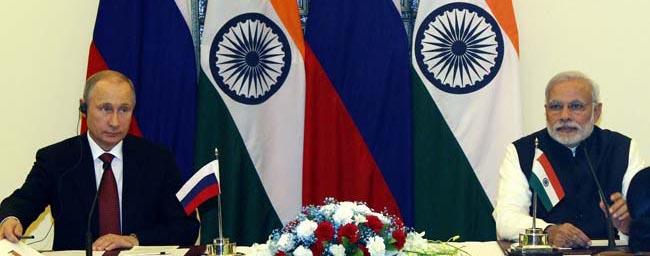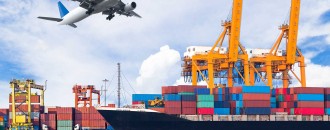
India-Russia trade relations back in spotlight
Prof. A.K. Sen Gupta | The Dollar Business
Last year saw the beginning of new bilateral trade ties between India and Russia, fuelled by India’s growing interest to push exports and a host of economic woes in Russia, and which resulted in the two countries aiming to triple bilateral trade to around $30 billion in coming years.
Indian Prime Minister Narendra Modi and Russian President Vladimir Putin held talks at the 15th Annual India- Russia Summit in New Delhi in December 2014 to further boost cooperation between the two strategic partners.
Both the countries sought to outline a joint vision of their ties and also ink major agreements in the field of energy, defence and trade. The two countries discussed issues related to bilateral strategic relationships to business ties and expressed confidence that the visit would take the bilateral relations to newer heights.
President Putin said “Our cooperation will get a boost, not just in military sphere but in the energy sector, agriculture, fertiliser and pharmaceutical products, civil aviation, diamond processing, science & culture and that our bilateral trade will reach an appropriate level. I expect our cooperation to move more beyond the exchange of finished products to the establishment of joint ventures and elaboration of joint projects which will help to implement PM Modi’s slogan Make in India.”
Russian economy is buffeted by Western sanctions over the Ukraine crisis and its currency, the rouble, suffering the biggest fall since 1998 due to the drop in global oil prices; Russia being a major oil exporter. Hence Putin wanted to seek deeper economic engagement with India to try to minimise impact of sanctions against Russia by USA and its Western allies.
The volume of bilateral trade between India and Russia was $10 billion in 2013 which is $1 billion less than during the previous year. At present, India’s share in total imports into Russia is merely 1%. However, India’s exports, particularly food items, to Russia have gone up since sanctions were imposed against the country. Putin emphasised the need for recovering the decline in bilateral trade with India.
Both sides felt that there is huge opportunity to improve it significantly to up to $30 billion by 2025.
Russia has turned to India with a host of agreements. The two countries signed as many as 20 agreements – seven inter-governmental and thirteen commercial. The pacts signed between the two sides covering such areas as oil exploration, infrastructure, nuclear energy, defence and diamonds amounted to a whopping $100 billion.
Topping the chart in Indo-Russian bilateral cooperation is the familiar nuclear energy sector. Russia’s state owned Rosatom will be building 12 new nuclear plants in India at a cost of $3 billion apiece. This means that the total cost of these nuclear plants alone would be $36 billion. It is reported that energy major Rosneft got into a 10-year contract to supply crude oil to Essar Oil. Russia also plans to manufacture one of its most advanced helicopters in India and explore the possibility of exporting from India.
With the assistance of the Russian company Sibur Holding, construction of one of the world’s largest butyl rubber producing plants will be set up in Gujarat. Diamond trade is also poised for a boost. Alrosa, a leading Russian diamond miner is looking to working with Indian cutting and polishing industry with Surat and Jaipur being major centres. Alrosa controls 25% percent of the world output of rough diamond, while the Indian diamond processing industry accounts for 60% by value of global polished diamond output.
The company will supply rough diamonds worth $700 million annually to Indian companies over three years. There is also a proposal for building a diamond hub in Mumbai through bilateral cooperation which can increase Indo-Russia bilateral trade turnover by $4-5 billion.
The two leaders have laid the ground for greater trade between the two countries in products such as diamonds, farm goods, heavy machinery and pharmaceuticals. Pharmaceutical is an area where there could be collaborations between the two as Russia wants to buy generics from India. Putin’s call for building Russia’s pharmaceutical industry to lessen dependence on the West creates the much needed opportunities for India.
Mutual investment is also an area where Indo-Russia cooperation is inadequate. India’s investment in Russia is about $5 billion, mainly in the energy sector, whereas Russia‘s investment in India is not more than $3 billion. Russia has been invited to invest in the Delhi-Mumbai industrial corridor, smart city construction and massive infrastructure building programmes. Russian company AFK SISTEMA, which has invested in the Indian telecommunication systems, has evinced keen interest in the development of smart cities in India.
President Putin said that Russian gas monopoly Gazprom delivered two LNG ship loads last year and signed a long term agreement with GAIL India Ltd for supply of 2.5 million tonnes a year of LNG for 20 years. Other areas of investment include information technology, space research, aircraft, automobile, assembly of industrial tractors and nano technology.
It is clear India and Russia have entered into a long-term trade-driven partnership, and the unique geopolitical and economic conditions have put the spotlight back on Indo-Russian relations.
Prof. A.K. Sen Gupta is Chair Professor,
JIMS, and Former Dean, Indian Institute of Foreign Trade (IIFT)





 to success.
to success.